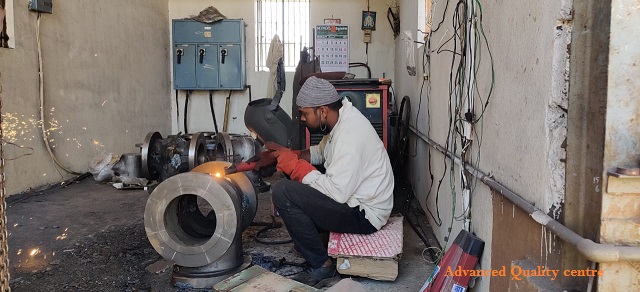Unless otherwise authorized by the engineer, any welding to the top flange of steel members for supporting floor form joists and finishing machine rails will not be permitted. Welding of hangers and supports to shear studs will be permitted as follows:
- The welder must be certified and use low hydrogen electrodes and proper
- No welding shall be permitted when the ambient temperature of the air is below 32° F (0°C) or when the lowest temperature during the preceding 12 hours has been below 0° F (-18°C).
- Windbreaks or shields shall be provided when the wind chill factor is strong or cold enough to prevent welding from being carried out in a normal manner without such
- Welding shall not be permitted on surfaces that are wet or exposed to Arc strikes on bridge flanges must be prevented at all times.

1. Welding of Railroad Bridge Deck Floors:
Railroad bridges that span highways are designed with a steel deck that covers the bridge and are welded together in the field. The special provisions that accompany railroad bridge lettings usually specify that a welding procedure be submitted for the field welding of the deck.
The welding procedure for the steel deck must not only cover the design of the welding joint, but it must also cover the sequence of welding. This welding procedure should receive the approval of the Office of Materials before welding is permitted.
Basically, all the requirements necessary for qualifying the procedure and sequence are in AWS under Sections 2, 3 and 5. The field inspector should understand the welding procedure and sequence thoroughly so he may help direct the welder in following the proper steps necessary.
Steel bridge decks involve longitudinal and transverse groove welds made in the flat position and are usually on plates of 1/2 in. (13 mm) thickness. Since welding is in both directions a multi- directional stress system can be built in of the procedure and sequence are not properly followed.
2. Welding of Reinforcing Steel:
The welding of deformed reinforcing steel is not permitted without the approval of a Structural Materials Engineer. The welding or tack welding of deformed reinforcing steel is detrimental to the mechanical properties of the bar, unless a special welding procedure with proper preheat and interpass temperature is established according to the carbon and manganese content of the bar.
Any field inspector who discovers welding on deformed reinforcing bars should notify their superiors, or with their permission, contact a Structural Materials Engineer. When the welding of deformed reinforcing steel is permitted it is part of the specifications or at a location where the stresses of the steel is almost zero or at a minimum.
we provide standard specifications for welding procedures for all welding process and Brazing. We offer Welder Procedure Specification, Welder Certificate Renewal Process, Procedure Qualification Record, Welder Qualification Testing, welder Training and Welder qualification services in Coimbatore, Trichy, Salem, Erode, Chennai.
Please feel free to reach us https://aqcinspection.com/training/ to learn more about any of the methods in detail.









